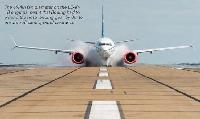Фотографии
-
Самолёты на фотографии: Boeing Boeing 737 MAX - США - 2016
-
Регистрационный номер: N8704Q N8704Q, also known as Airplane 4, is used for function and reliability testing.
The 737 MAX is similar to the 737NG in many respects but also has some innovations including the LEAP-1B engines and AT Winglets.Самолёты на фотографии: Boeing Boeing 737 MAX - США - 2016
-
Регистрационный номер: N8702L Boeing 737 MAX 8 N8702L (c/n 36989) undertaking water spray testing in Glasgow, Montana. Test pilots took the jet through the standing water to show engineers where the water hit the MAX as it passed through the trough and whether the water was ingested into the CFM International LEAP-1B engines. Community noise testing was also carried out at Glasgow. A Boeing spokesman told AIR International that tests simulating revenue service also continue. Certification is scheduled for the first quarter of 2017 and service entry in the first half of the year.
Самолёты на фотографии: Boeing Boeing 737 MAX - США - 2016
-
Регистрационный номер: N8703J [2] This jet, N8703J (airplane 3, c/n 42556), is one of four aircraft that has been used for flight and certification testing of the 737 MAX 8, pictured at Moses Lake, is used for propulsion and systems tests.
The Boeing 737 MAX has been grounded since March 2019 and isn't expected to return to service until late this year at the earliest, with some customers pulling the aircraft from schedules until 2020.Самолёты на фотографии: Boeing Boeing 737 MAX - США - 2016
-
Регистрационный номер: N8701Q The 737 MAX 8 is just over 129ft (39m) long, with a 117ft (36m) wingspan and a maximum take-off weight of 181,200 lb (82,191 kg).
Самолёты на фотографии: Boeing Boeing 737 MAX - США - 2016
-
Регистрационный номер: N8703J [2] Boeing is promising the 737 MAX 8 will burn 14% less fuel compared to a 737NG, with the LEAP-1B engines contributing 11% of the reduction.
Самолёты на фотографии: Boeing Boeing 737 MAX - США - 2016
-
The upwards-facing aerofoil on the AT Winglet vectors the inward, upward and slightly forward lift components of the airflow around the wing and the lower aerofoil generates a further vertical lift component that is vectored away from the fuselage and slightly forwards.
Самолёты на фотографии: Boeing Boeing 737 MAX - США - 2016
-
Самолёты на фотографии: Boeing Boeing 737 MAX - США - 2016
-
The 69.4in fan diameter on the LEAP-1B engines meant that Boeing had to extend the nose landing gear by 8in to ensure sufficient ground clearance.
Самолёты на фотографии: Boeing Boeing 737 MAX - США - 2016
-
The four large multifunction displays give the 737 MAX a very different look from the 737NG's flight deck, but only one panel has been moved. There are no changes to the checklists or flow patterns that pilots use.
Самолёты на фотографии: Boeing Boeing 737 MAX - США - 2016
Статьи
- -
- Airscene
- MAX: The 737 Refreshed
- A.Mladenov - Albatros Renewed /Military/
- D.Isby - Revolutionary Aircraft and an Electric Future /Technology/
- I.Harding - A New Era /Military/
- J.Kraak - Train as you Fight /Military/
- M.Ayton - Archangel: Crop Duster to Tank Buster /Military/
- N.Graf - End of a Legend /Military/
- N.Pittaway - Next Get Airlifter /Military/









